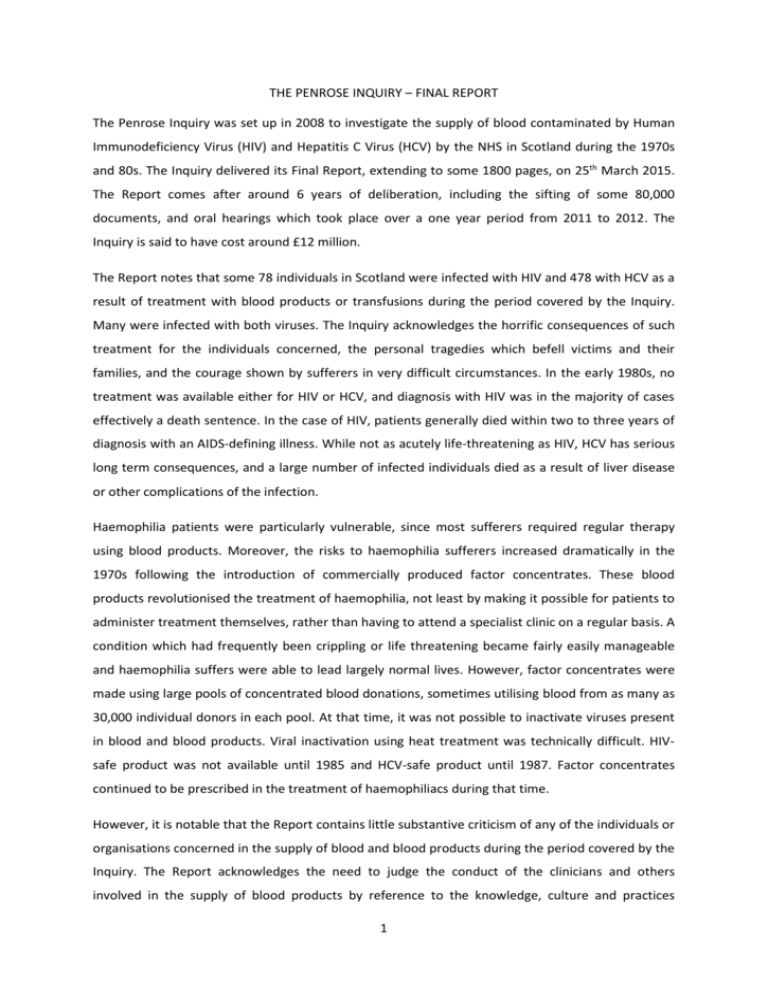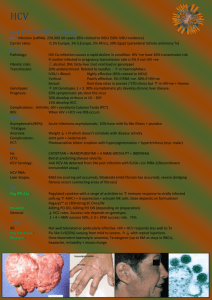The Penrose Inquiry - Summary
advertisement

THE PENROSE INQUIRY – FINAL REPORT The Penrose Inquiry was set up in 2008 to investigate the supply of blood contaminated by Human Immunodeficiency Virus (HIV) and Hepatitis C Virus (HCV) by the NHS in Scotland during the 1970s and 80s. The Inquiry delivered its Final Report, extending to some 1800 pages, on 25th March 2015. The Report comes after around 6 years of deliberation, including the sifting of some 80,000 documents, and oral hearings which took place over a one year period from 2011 to 2012. The Inquiry is said to have cost around £12 million. The Report notes that some 78 individuals in Scotland were infected with HIV and 478 with HCV as a result of treatment with blood products or transfusions during the period covered by the Inquiry. Many were infected with both viruses. The Inquiry acknowledges the horrific consequences of such treatment for the individuals concerned, the personal tragedies which befell victims and their families, and the courage shown by sufferers in very difficult circumstances. In the early 1980s, no treatment was available either for HIV or HCV, and diagnosis with HIV was in the majority of cases effectively a death sentence. In the case of HIV, patients generally died within two to three years of diagnosis with an AIDS-defining illness. While not as acutely life-threatening as HIV, HCV has serious long term consequences, and a large number of infected individuals died as a result of liver disease or other complications of the infection. Haemophilia patients were particularly vulnerable, since most sufferers required regular therapy using blood products. Moreover, the risks to haemophilia sufferers increased dramatically in the 1970s following the introduction of commercially produced factor concentrates. These blood products revolutionised the treatment of haemophilia, not least by making it possible for patients to administer treatment themselves, rather than having to attend a specialist clinic on a regular basis. A condition which had frequently been crippling or life threatening became fairly easily manageable and haemophilia suffers were able to lead largely normal lives. However, factor concentrates were made using large pools of concentrated blood donations, sometimes utilising blood from as many as 30,000 individual donors in each pool. At that time, it was not possible to inactivate viruses present in blood and blood products. Viral inactivation using heat treatment was technically difficult. HIVsafe product was not available until 1985 and HCV-safe product until 1987. Factor concentrates continued to be prescribed in the treatment of haemophiliacs during that time. However, it is notable that the Report contains little substantive criticism of any of the individuals or organisations concerned in the supply of blood and blood products during the period covered by the Inquiry. The Report acknowledges the need to judge the conduct of the clinicians and others involved in the supply of blood products by reference to the knowledge, culture and practices 1 available or extant at the time, and not with hindsight. HIV was an entirely unknown virus, unidentified until 1983. It was not finally accepted until around 1984 that HIV in contaminated blood products was the cause of AIDS infections in haemophilia patients. The HCV virus was not identified until 1988 albeit its existence had been suspected for some time before that. The Report’s most striking finding is that, other than by ceasing to use factor concentrates the infection of haemophilia patients with HIV could not have been prevented. Moreover, even after autumn 1983 when the first death of a UK haemophilia patient from AIDS had occurred, it was reasonable for clinicians to continue to treat at least some patients with factor concentrates. Such products produced such marked – in some cases life-saving – benefits, that clinicians were justified in continuing to use them, particularly in the period when it was not clear that contaminated blood was in fact the cause of AIDS in haemophilia patients. The use of commercially produced factor concentrates markedly reduced with the increased availability of NHS product, drawn from UK donors and therefore generally safer than imported commercial product (although HIV infections from NHS product did occur). The Inquiry’s other principal findings are that: The policies and practices applicable to the selection and screening of blood donors in the late 1970s and early 1980s were broadly acceptable, and the Inquiry did not identify specific measures which could have been introduced and were not. The Inquiry has “no criticism to make” of those involved in viral inactivation of blood products in Scotland. In particular, it accepts that virally-inactivated blood products could not have been made available more quickly than they were. Scotland was among the very first nations in the world to introduce such products. It was unfortunate, particularly in relation to the period between 1985 and 1987, that little or no information or guidance on the availability and use of virally inactivated blood products was available to Scottish hospitals which did not have dedicated haemophilia centres. It may be that some haemophilia patients were given factor concentrates during that period which still contained HCV. However, even if such guidance had been available, there was no evidence that an adequate supply of such products could have been made available to treat Scottish patients. There was no evidence to support the introduction of “surrogate testing” for HCV in the late 1980s and early 1990s. HIV testing was introduced as quickly as it reasonably could have been. There was a delay of around 10 months in the introduction of HCV testing in 1991 because of a policy that testing should be introduced at the same time throughout the UK. It could have been introduced in Scotland significantly earlier, although to do so would have required the Minister 2 responsible for the NHS in Scotland to depart from well-established UK government policy. When it was introduced, however, it was with second generation testing kits which were more reliable than those which had first been evaluated. Some patients were not asked to consent to testing for HIV, and were not given sufficient information about the risks associated with treatment with factor concentrates. However, there was at the time no published code of conduct for treating physicians in relation to such matters, there was very little knowledge about the disease in the early 1980s, and the culture of the medical profession was at that time essentially paternalistic. Doctors and patients expected the clinician to be the best judge of the appropriate treatment. Judged by the standards of the time, there was no basis for criticising individual clinicians about these matters. Indeed, the Inquiry notes that “the effect of AIDS and the responses to it have had a more profound effect on doctor/patient relationships than any other single event.” The only concrete recommendation of the Inquiry is that those who received blood transfusions prior to 1991 should be tested for HCV. Victims and families have reacted negatively to the terms of the Report, with some regarding it as a “whitewash”. Some have threatened legal action against the Government, although it is unclear on the basis of the Report what the grounds for such an action would (or could) be. Despite the epic scale and scope of the Report, it seems unlikely that it will constitute a final resolution of the issues arising from these tragic events, or assuage the anger of those who feel betrayed by clinicians who, while seeking to administer life-saving treatment, unwittingly caused many of their patients irreparable harm. 3




